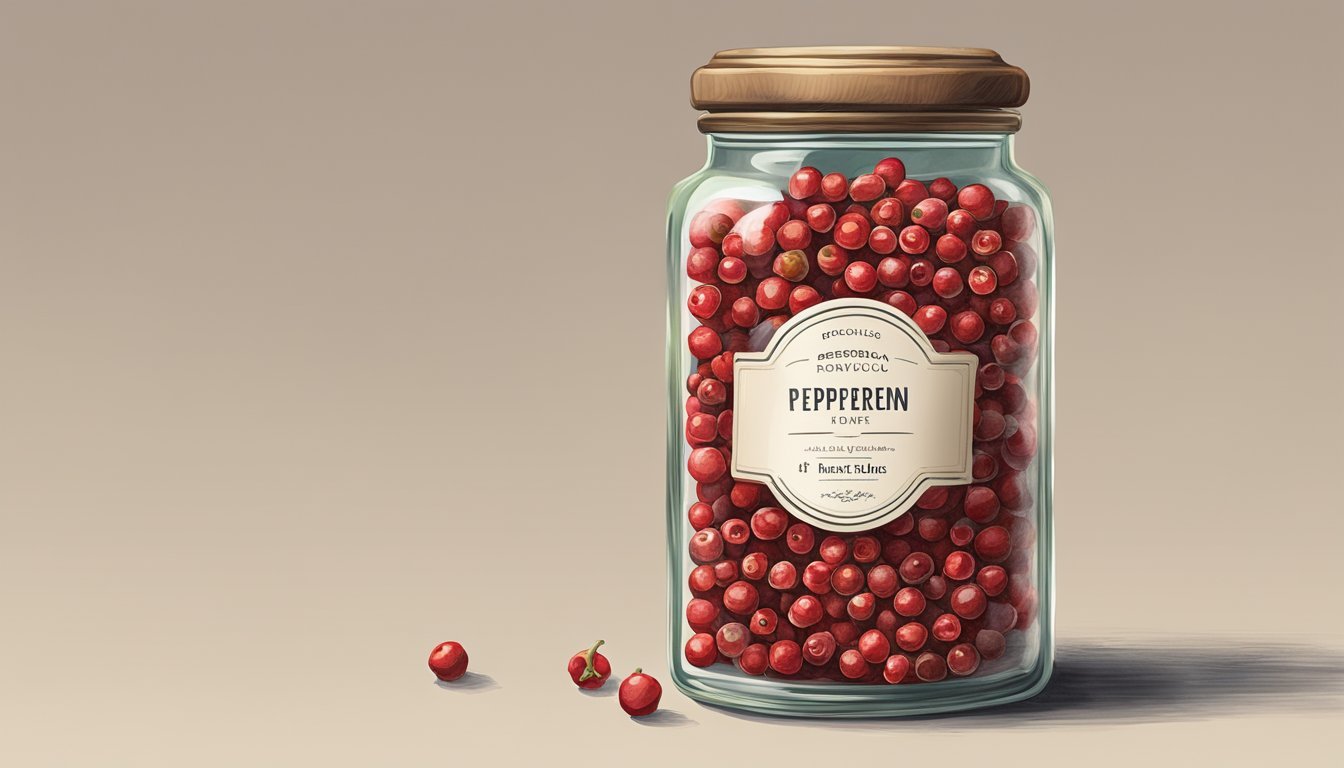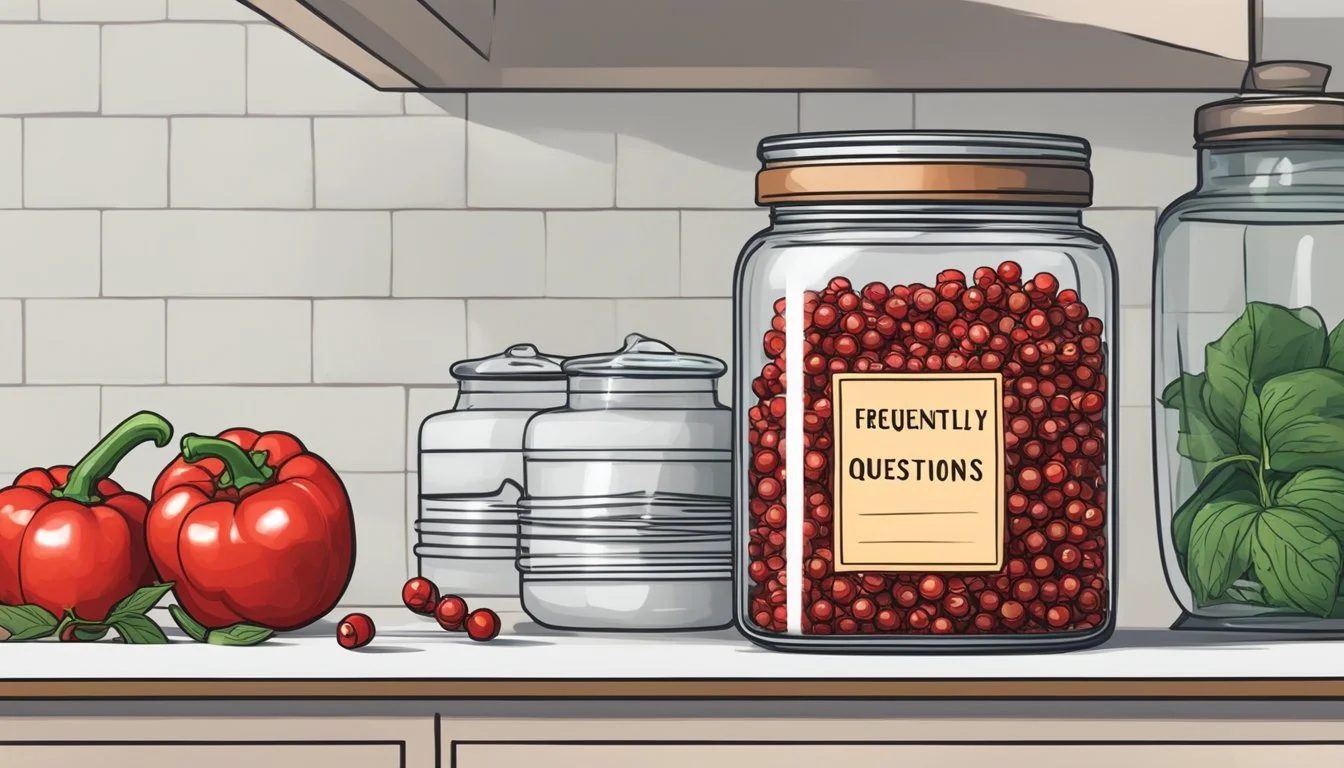How Long Do Red Peppercorns Last?
Shelf Life and Storage Tips
Red peppercorns, the ripe berries of the Piper nigrum plant, are a vibrant and flavorful variety of pepper that is prized in various cuisines for their unique taste. As a spice, they add depth to dishes with their complex spiciness and slight fruity notes. Understanding the shelf life of red peppercorns is essential for culinary enthusiasts who seek to maintain the integrity of their spice's flavor profile.
Given their preservative qualities, red peppercorns can last a considerable amount of time when stored properly. The spice's lifespan, however, is contingent upon factors such as storage methods and the form in which it is used—whole or ground. Whole red peppercorns generally last longer than their ground counterparts because they have a lower surface area exposed to environmental elements that can lead to degradation.
To preserve their quality, red peppercorns should be stored in an airtight container in a cool, dry place away from direct sunlight. Under such conditions, they can retain their flavor and potency for several years. The signs of deterioration include dull color, diminished aroma, and a loss of the spice's piquant flavor, indicating that it may be time to replace them.
Identifying Red Peppercorns
When discussing red peppercorns, it is crucial to understand their unique characteristics and the distinctions among the different varieties. This will ensure proper identification and use.
Characteristics of Red Peppercorns
Red peppercorns are the fully ripened fruits of the Piper nigrum vine. In their mature state, they develop a rich red color that distinguishes them from their unripe black and green counterparts. These peppercorns are known for their complex aroma and nuanced flavor profile, which can be both fruity and spicy. When dried, the red peppercorns may take on a darker hue, but their characteristic redness is usually still noticeable.
Varieties and Their Distinctions
There are several varieties of red peppercorns, and although they all hail from the same piper nigrum species, subtle differences may be observed:
Kampot Red Pepper: Grown in the Kampot region of Cambodia, this variety is renowned for its sweet flavor with hints of caramel.
Pondicherry Red Pepper: Found in Indian markets, these peppercorns possess a full-bodied flavor that is often sought after by culinary enthusiasts.
Each variety of red peppercorn retains the distinct piperine-induced heat associated with other peppercorn colors, yet they stand out due to their color and the stage of fruit maturity at which they are harvested.
Storage Fundamentals
Effective storage is crucial for maintaining the quality and extending the shelf life of red peppercorns. By adhering to optimal conditions and using appropriate containers, one can ensure that the spice retains its potency and flavor.
Ideal Storage Conditions
The key to preserving red peppercorns lies in three central factors: a cool, dry, and dark environment. These conditions prevent the degradation of essential oils responsible for the spice's aroma and taste.
Cool Temperature: Store red peppercorns in a place where the temperature is consistently cool but not subject to extreme cold.
Low Moisture: A dry area reduces the risk of mold growth and maintains the integrity of the peppercorns.
Reduced Light Exposure: Keep peppercorns away from direct sunlight as it can fade the color and diminish flavor.
Containers and Packaging
Selecting the right type of container is equally important to maintain the quality of red peppercorns.
Airtight Container: An airtight container is imperative to shield the peppercorns from moisture and air, both of which can negatively affect their shelf life.
Materials: Glass or metal containers with tight-fitting lids are excellent choices. They prevent air exposure and protect from light if opaque or stored in a dark cupboard.
By following these storage fundamentals, one can preserve the quality and extend the storage time of red peppercorns, ensuring their best use in culinary applications.
Maximizing Shelf Life
To preserve peak quality and ensure maximum shelf life of red peppercorns, specific storage techniques should be applied according to their form and the surrounding conditions. The key aspects to consider are whether the peppers are whole or ground and the influence of temperature and moisture during storage.
Whole vs Ground
Whole Red Peppercorns usually retain their flavor and potent qualities longer than their ground counterparts. The intact outer layer of whole peppercorns safeguards the essential oils inside, which are responsible for their aroma and taste.
Shelf Life: typically, whole peppercorns stay fresh for up to 3 to 5 years when stored properly.
Ground Red Pepper, on the other hand, exposes more surface area to the environment, which can lead to a quicker degradation of quality.
Shelf Life: Generally, ground red pepper remains fresh for 1 to 2 years, with diminished potency over time.
Temperature and Moisture Impact
Storage conditions have a significant impact on the shelf life and freshness of red peppercorns. Both temperature and moisture can influence the longevity and quality of the pepper.
Temperature: Heat can accelerate the loss of essential oils in red peppercorns, reducing their flavor and freshness.
Recommendation: Store in a cool, dry place away from direct sunlight and any heat sources.
Moisture: Humidity can encourage the growth of mold and cause red peppercorns to clump, which diminishes their quality.
Recommendation: Ensure storage in an airtight container to minimize exposure to moisture.
In summary, for Whole Red Peppercorns, an airtight container away from heat and light extends their shelf life, preserving freshness for years. Ground Red Pepper benefits similarly from such storage but inherently lasts a shorter period. Observing these guidelines helps maintain the quality of red peppercorns from the time they are packaged until they reach their expiration date.
Culinary Uses
Red peppercorns provide a unique combination of heat and sweet fruitiness to dishes. They are versatile ingredients that enhance a wide range of culinary creations with their distinct flavor profile.
Incorporating Into Dishes
Red peppercorns can be used whole, crushed, or ground to infuse their flavor into various recipes. When cooking, chefs often add whole peppercorns to soups and sauces to extract their flavor during the simmering process. For salads and meat dishes, crushed peppercorns are preferred as they offer a more direct heat and flavor. Ground red peppercorns are commonly used as a seasoning for seafood, beef, and pork, either incorporated into spice rubs or sprinkled on before cooking. In baking, ground red peppercorns can add an unexpected twist to sweet and savory pastries.
Flavor Pairings and Combinations
Red peppercorns' sweet and mildly spicy flavor harmonizes well with a variety of ingredients, allowing them to be a valuable component in diverse cuisines. They pair exceptionally well with:
Meat: Enhances the natural savoriness of beef and pork.
Seafood: Complements the delicacy of various seafood dishes. (What wine goes well with seafood dishes?)
Baking: When used with discretion, can bring depth to sweet bakes.
A culinary staple, red peppercorns contribute to the creation of bold and aromatic recipes, making them an essential ingredient in both traditional and innovative cooking.
Health Considerations
When discussing the health considerations of Red peppercorns, it's essential to focus on their nutritional content and digestive benefits. These aspects directly impact an individual's health when consuming Red peppercorns.
Nutritional Content
Red peppercorns are a source of several essential nutrients. They contain a modest amount of vitamin K, which is vital for blood clotting and bone health. Additionally, Red peppercorns provide iron, which is crucial for oxygen transport in the blood and the overall function of several enzymes.
Nutritional Highlights:
Vitamin K: Important for bone health
Iron: Essential for oxygen transport
Digestive Benefits
The consumption of Red peppercorns may aid in digestion. They assist in breaking down food efficiently, thus reducing indigestion. The active compound in peppercorns, piperine, can stimulate the digestive tract, resulting in the secretion of more digest enzymes. This action aligns well with the prevention of digestive issues and enhances the overall nutrient absorption.
Digestion-related benefits:
Enhanced breakdown of foods
Reduced incidence of indigestion
Frequently Asked Questions
In this section, readers will find in-depth answers to common inquiries regarding the longevity and proper use of red peppercorns. This information empowers them to maintain the spice's quality and flavor.
Shelf Life Queries
How long do red peppercorns last?
Unopened and stored under the right conditions, red peppercorns can remain fresh for up to three years. Factors such as storage environment play a critical role in preserving their flavor and potency.
What are the ideal storage conditions for red peppercorns?
For maximum shelf life, red peppercorns should be kept in a tightly sealed container to prevent moisture and contaminants, and stored in a cool, dry place away from direct sunlight and heat sources.
Usage Tips
How can one tell if red peppercorns have lost their flavor?
A tell-tale sign is a noticeable decrease in aroma and taste. Freshly ground red peppercorns should release a pungent scent and robust flavor when used for seasoning. If this is diminished, the peppercorns may be past their prime.
What are the best practices for using red peppercorns to ensure good pepper quality?
Using red peppercorns within their recommended shelf life ensures the best quality for seasoning. Grinding them fresh, as needed, instead of pre-ground, typically delivers a more intense flavor.
Comparative Analysis
This section offers a focused comparison between red peppercorns and other peppercorn varieties, specifically considering their longevity and the variations in freshness and potency.
Red vs Other Peppercorn Types
Red peppercorns differ from black, white, and green peppercorns in both flavor and shelf life.
Black peppercorns: They are known for their strong, pungent flavor and are the most common. Black peppercorns, when stored properly in a cool, dry place, can remain potent for up to 4 years.
White peppercorns (how long do white peppercorns last?): These are black peppercorns with the outer layer removed, offering a milder flavor. They can be kept fresh for a similar duration as black peppercorns.
Green peppercorns: They are unripe when picked and have a fresher, zesty flavor. Green peppercorns are more perishable and best when used within a year.
Red/pink peppercorns: Actually not true peppercorns, but berries from the Brazilian pepper tree, they have a milder, fruitier flavor. Red peppercorns are delicate and have a shorter shelf life, typically remaining fresh for about 1 year when stored properly.
Freshness and Potency Variations
The freshness and potency of peppercorns impact the quality and taste of the dishes in which they are used. Over time, all types of peppercorns can lose their potency, thus affecting their spice profile.
Black pepper retains potency longer due to its strong flavor.
White pepper, with its milder taste, may seem to lose its punch more noticeably as it ages.
Green pepper is less pungent than black pepper but is valued for its fresh, vivid flavor which diminishes faster.
Red peppercorns, while offering a milder flavor profile than black peppercorns, must be used more quickly after purchase to maintain their distinctive taste.








